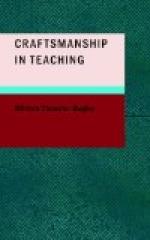One important point is likely to be overlooked in the consideration of examinations,—the fact, namely, that the form and content of the questions have a very powerful influence in determining the content and methods of instruction. Is it not pertinent, then, to inquire whether examination questions cannot be so framed as radically to improve instruction rather than to encourage, as is often the case, methods that are pedagogically unsound? Granted that it is well for the child to memorize verbatim certain unrelated facts, even to memorize some facts that have no immediate bearing upon his life, granted that this is valuable (and I think that a little of it is), is it necessary that an entire year or half-year be given over almost entirely to “cramming up” on old questions? Would it not be possible so to frame examination questions that the “cramming” process would be practically valueless?
What the pupil should get from geography, for instance, is not only a knowledge of geographical facts, but also, and more fundamentally, the power to see the relation of these facts to his own life; in other words, the ability to apply his knowledge to the improvement of adjustment. Now this power is very closely associated with the ability to grasp fundamental principles, to see the relation of cause and effect working below the surface of diverse phenomena. Geography, to be practical, must impress not only the fact, but also the principle that rationalizes or explains the fact. It must emphasize the “why” as well as the “what.” For example: it is well for the pupil to know that New York is the largest city in the United States; it is better that he should know why New York has become the largest city in the United States. It is well to know that South America extends very much farther to the east than does North America, but it is better to know that this fact has had an important bearing in determining the commercial relations that exist between South America and Europe. Questions that have reference to these larger relations of cause and effect may be so framed that no amount of “cramming” will alone insure correct answers. They may be so framed that the pupil will be forced to do some thinking for himself, will be forced to solve an imaginary situation very much as he would solve a real situation.
Examination questions of this type would react beneficially upon the methods of instruction. They would tend to place a premium upon that type of instruction that develops initiative in solving problems, instead of encouraging the memoriter methods that tend to crush whatever germs of initiative the pupil may possess. This does not mean that the memoriter work should be excluded. A solid basis of fact is essential to the mastery of principles. Personally I believe that the work of the intermediate grades should be planned to give the pupil this factual basis. This would leave the upper grades free for the more rational work. In any case, I believe that the efficiency of examinations may be greatly increased by giving one or two questions that must be answered by a reasoning process for every question that may be answered by verbal memory alone.




